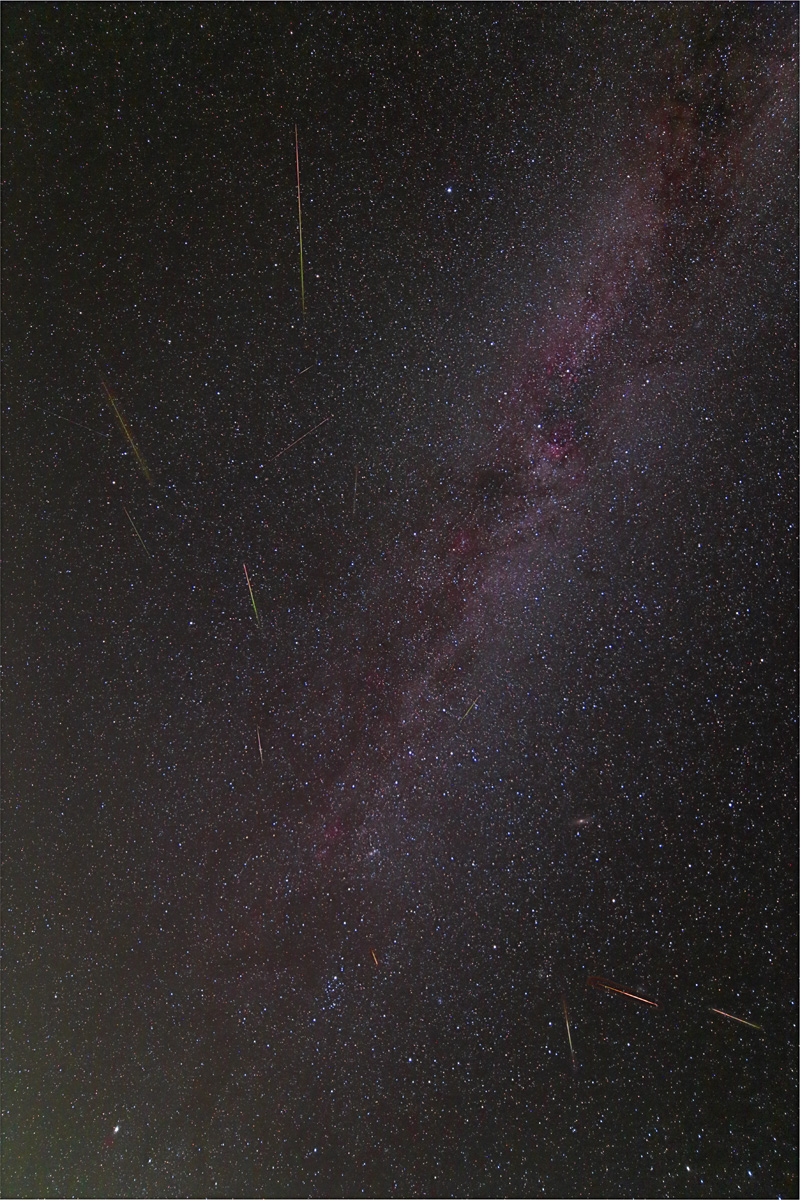This past weekend (Friday through Monday night) I was at my favorite site for astrophotography, SkyView Acres, in Goldendale, WA in my first opportunity to attend a star party this year. The first 2 nights were not expected to have good weather, and the forecast was largely correct, but this gave me some time to work out some ‘bugs’ that arose from new equipment and software – and from not having done any AP work for a full year!
August 12(ish) is the peak of the Perseid meteor shower, so we were a bit early, but still saw plenty of meteors. The above photo was made by combining 36 frames selected from 782 exposures made Monday night between 10PM and 2AM. I first selected 18 frames that had no meteors, satellite tracks, or airplanes, and stacked them to create a low noise background image of the Milky Way and surrounding stars. The image is (roughly) centered on the constellation Cassiopeia, and Perseus (the radiant constellation for the Perseid Meteor Shower) is just below that. I then searched through the frames for exposures that had meteors in them. This is not as easy as it might seem. First, there are a lot more frames that include satellite and airplane trails than meteors. Meteors are different in that they (almost always) appear in a single frame, while satellite and airplane trails usually ‘march along’ through multiple exposures. Meteors also tend to change brightness (and often color) over the length of the streak. The second challenge in finding meteors in the exposures is that many of them are quite small and dim, so easily missed.
Each of the frames containing a meteor was then aligned with the background image, but to keep things simple, I then deleted everything but the area right around the meteor streak before blending it into the composite image.
You can see in this photo that most of the meteor streaks ‘point’ toward Perseus. The end of the streak that is closest to Perseus is the beginning – the point where a piece of debris entered Earth’s atmosphere and heated up to the point that it caused surrounding gases to glow. The particle (most of them are no bigger than a grain of sand) then either burns up or is slowed down enough that it is no longer hot enough to produce any light. The length and brightness of the streak is partially proportional to the mass of the particle, but also depends on the direction it is moving relative to the viewer. Near the bottom center is a very short, bright streak that is probably short because it is moving along a line that is not too far off from a straight line toward the viewer (me). In fact, I have seen meteors that appear as just a point of light that rapidly increases in brightness, then disappears. This is what you see when a meteor is coming straight toward you! But not to worry; almost none of these particles make it to Earth’s surface, and far fewer reach Earth with much speed, as they are slowed by friction with our atmosphere. The streaks that are not pointing toward Perseus are probably not Perseid meteors (well, that’s kind of true by definition), but are rather sporadic meteors that happen all the time – just not as frequently as meteors that are part of a ‘shower’.
So, what is a meteor shower? When a comet (don’t mix up comets and meteors – they are very different) passes through our solar system it usually leaves a trail of debris/dust that is almost static. That is, it doesn’t move very much over many years of time. If Earth’s orbital path passes through this field of debris, some of the particles will hit out atmosphere and start to heat up. In the case of the Perseid Meteor Shower, the debris is from Comet Swift-Tuttle. Since the debris field does not move, Earth passes through the field every year at the same time, thus making a predictable meteor shower.
All the frames I used for this image were captured using a Canon 6D on an iOptron SkyTracker (a simple, inexpensive tracking mount). The camera is modified for hydrogen-alpha sensitivity, which is why you see quite a lot of red in places, including the North America Nebula. The lens was a Samyang 14mm f/2.8, stopped down to f/4. The exposures were all 15 seconds at ISO 3200. One of the tricks in photographing a meteor shower is choosing the right exposure length. Most meteors start and end in a fraction of a second and their brightness in the captured image is not related to exposure duration. The background, however, does get brighter as you increase the exposure length (assuming f-stop and sensitivity are kept the same). So the brightness of the meteor streaks relative to the background depends on the exposure duration, while the overall brightness is adjusted using aperture and ISO settings. This does not mean that 15 seconds is always the right answer. It might be anywhere from a few seconds to a full minute or more. If you use very short exposures there is a possibility that a meteor streak will be ‘cut off’ by the shutter at either the beginning or end of the exposure. Also, of course, if you use short exposures with no delay between them you will end up with a lot of frames to search through!
